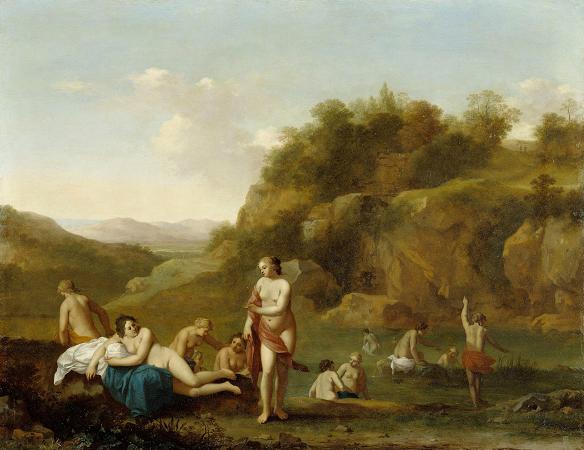Bathers. Bathing is the washing of the body with a liquid, usually water or an aqueous solution, or the immersion of the body in water. It may be practiced for personal hygiene, religious ritual or therapeutic purposes. By analogy, especially as a recreational activity, the term is also applied to sun bathing and sea bathing. Bathing can take place in any situation where there is water, ranging from warm to cold. It can take place in a bathtub or shower, or it can be in a river, lake, water hole, pool or the sea, or any other water receptacle. The term for the act can vary. For example, a ritual religious bath is sometimes referred to as immersion, the use of water for therapeutic purposes can be called a water treatment or hydrotherapy, and two recreational water activities are known as swimming and paddling. Throughout history, societies devised systems to enable water to be brought to population centres. The oldest accountable daily ritual of bathing can be traced to the ancient Indians. They used elaborate practices for personal hygiene with three daily baths and washing. These are recorded in the works called grihya sutras and are in practice today in some communities. Ancient Greece utilized small bathtubs, wash basins, and foot baths for personal cleanliness. The earliest findings of baths date from the mid-2nd millennium BC in the palace complex at Knossos, Crete, and the luxurious alabaster bathtubs excavated in Akrotiri, Santorini. The Greeks established public baths and showers within gymnasiums for relaxation and personal hygiene. The word gymnasium comes from the Greek word gymnos, meaning naked. Ancient Rome developed a network of aqueducts to supply water to all large towns and population centres and had indoor plumbing, with pipes that terminated in homes and at public wells and fountains. The Roman public baths were called thermae. The thermae were not simply baths, but important public works that provided facilities for many kinds of physical exercise and ablutions, with cold, warm, and hot baths, rooms for instruction and debate, and usually one Greek and one Latin library. They were provided for the public by a benefactor, usually the Emperor. Other empires of the time didn't show such an affinity for public works, but this Roman practice spread their culture to places where there may have been more resistance to foreign mores. Unusually for the time, the thermae were not class-stratified, being available to all for no charge or a small fee. With the fall of the Roman Empire, the aqueduct system fell into disrepair and disuse. But even before that, during the Christianization of the Empire, changing ideas about public morals led the baths into disfavor. Before the 7th century, the Japanese likely bathed in the many springs in the open, as there is no evidence of closed rooms. In the 6th to 8th centuries the Japanese absorbed the religion of Buddhism from China, which had a strong impact on the culture of the entire country. Buddhist temples traditionally included a bathhouse for the monks. Due to the principle of purity espoused by Buddhism these baths were eventually opened to the public. Only the wealthy had private baths. The first public bathhouse was mentioned in 1266. In Edo, the first sento was established in 1591. The early steam baths were called iwaburo or kamaburo. These were built into natural caves or stone vaults. In iwaburo along the coast, the rocks were heated by burning wood, then sea water was poured over the rocks, producing steam. The entrances to these bath houses were very small, possibly to slow the escape of the heat and steam. There were no windows, so it was very dark inside and the user constantly coughed or cleared their throats in order to signal to new entrants which seats were already occupied. The darkness could be also used to cover sexual contact. Because there was no gender distinction, these baths came into disrepute. They were finally abolished in 1870 on hygienic and moral grounds. Author John Gallagher says bathing was segregated in the 1870s as a concession to outraged Western tourists. At the beginning of the Edo period there were two different types of baths. In Edo, hot-water baths were common, while in Osaka, steam baths were common. At that time shared bathrooms for men and women were the rule. These bathhouses were very popular, especially for men. Bathing girls were employed to scrub the guests' backs and wash their hair, etc. In 1841, the employment of yuna was generally prohibited, as well as mixed bathing. The segregation of the sexes, however, was often ignored by operators of bathhouses, or areas for men and women were separated only by a symbolic line.
more...














